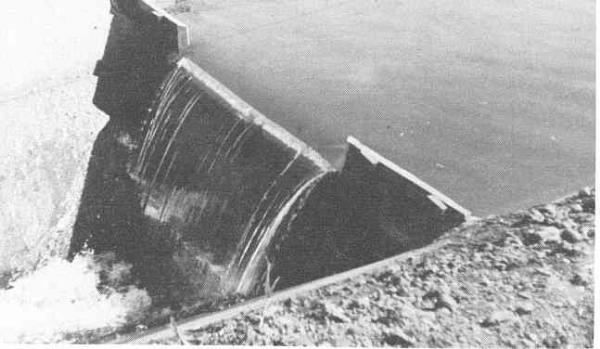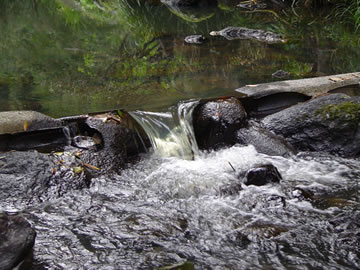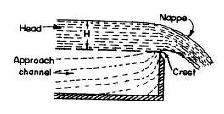Weir Dams
A weir dam is a small overflow-type dam commonly used to raise the level of a river or stream. Weir dams have historically been used to create mill ponds but have also been used to create fishing ponds or to slow the rate of erosion. Water flows over the top of a weir. Since the weir is the portion where water is overflowing, a long weir allows a lot more water with a small increase in overflow depth. This is done in order to minimize fluctuation in the depth of the river upstream with changes in the flow rate of the river. Weirs also give hydrologists and engineers a simple method of measuring the rate of flow over the weir. There are different types of weirs. It may be a simple metal plate with a V notch cut into it or it may be a concrete and steel structure across the bed of a river.
Sharp Crested Weir
A sharp-crested weir allows the water to fall cleanly away from the weir. Sharp crested weirs are typically thin metal plates

Broad Crested Weir
Broad crested weirs are large structures that are generally constructed from reinforced concrete and which usually span the full width of the river. 
Crump Weir
A Crump weir is a fixed weir dam with water flowing over it and usually it has a trapezoidal shape while being made out of concrete.If the down-stream level below the weir crest is about the same as the up-stream it can be known as an underwater weir

Proportional Weir or "V" notch weir
A specially shaped weir in which the flow through the weir is directly proportional to the head.

Combination Weir
For accurate flow measurement over a wider range of flow rates, a combination weir combines 2 or more types of weirs. Below a V-Notch weir with a crump weir

There are several terms associated with weir dams.
Nappe the flow or discharge after the crest.
Head the level above the crest
Crest the width of the top of the weir
Approach the level of the river below crest also know as the datum.

Wetlands are referred to as "nature's kidneys" because of their filtering and nutrient-processing functions.Wetlands catch runoff, which is rain water that drains from the land and absorbs it before entering open water. Heavy metals and pollutants contained in the run off are filtered and retained in the wetland. You can find more plants and animals per acre than any other kind of habitat.
This cache is located in the glacier zone called New Castle till plain and drainage way. Glaciers not only shaped the landscape of Indiana, but encouraged evolution and adaptations in the plants and animals we see today in Indiana.
Hydrology: Though the Middle Fork of the Anderson River has an established conservancy district and flood-control impediments, the main channel of the Anderson River has no conservancy district or flood control impediments.
1. What type of weir dam is this?
2. What is the dam used to create? If the dam was no longer here how would it affect the Eco-system in the wetland?
3. Why is it important to the health of the ecosystem?
4. What is the nick name for wetlands(nature's what)?
5. What is the approximate drop in feet from the crest to the river below?
6. Is water flowing over the dam? What does this mean to the wetland?
7. How will the flow rate of the dam affect the river confluence just west of the dam?
8. BONUS! Post a picture of yourself and your GPSr with the area behind the dam.
Plenty of parking along the road please stay on public sidewalk while doing this cache.